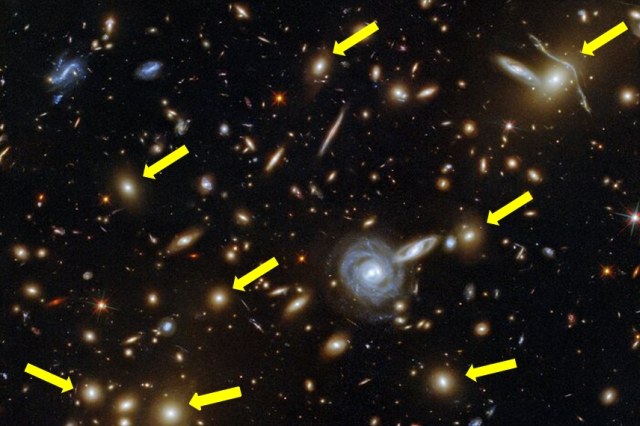The great variety of galaxies in today's universe. The arrows indicate some examples of high-mass spheroidal galaxies (Credit: ESA/Hubble & NASA, F. Pacaud, D. Coe)
A collaboration between the University of Edinburgh (UK) and the University of Bologna has identified the oldest quiescent galaxy – i.e. one that no longer forms stars – so far known. Scientists observed the galaxy - called GS-9209 - 1.25 billion years after the Big Bang: an epoch that corresponds to about 9% of the current age of the Universe. And by that time, the formation of new stars inside of it had already stopped for about half a billion years.
The discovery - published in the journal Nature - was possible thanks to the James Webb Space Telescope and offers new clues for understanding the physical processes that drive the formation and evolution of galaxies. In particular, the study highlights the correlation between the presence of supermassive black holes and the inhibition of the ability of galaxies to form new stars.
The stellar mass of the GS-9209 galaxy is very similar to that of the Milky Way: 40 billion times greater than the mass of the Sun. However, unlike our galaxy, GS-9209 has a spheroidal (and not spiral) shape, and it is significantly compact: it is about ten times smaller than the Milky Way. The spectroscopic data reveal that the galaxy formed between 600 and 800 million years after the Big Bang, that is to say: when the Universe was about 4% of its current age. After that, the forming of new stars stopped.
"The quiescent state in which we found GS-9209 is closely related to the presence, in the centre of the galaxy, of a supermassive black hole with a mass between half a billion and a billion times the mass of the Sun", explains Andrea Cimatti, director of the “Augusto Righi” Department of Physics and Astronomy of the University of Bologna, one of the authors of the study. "It is a mass five times larger than one might expect considering the number of stars in the galaxy: a figure that could explain why the star formation process has stopped".
The growth of supermassive black holes releases enormous quantities of energy in the form of radiation, which heats and pushes away the gas within the galaxy, eliminating the conditions that allow star formation (the presence of gas and low temperatures).
The galaxy discovered with the James Webb Space Telescope (Carnall et al. 2023). The image in the white box shows a zoom of its spheroidal shape and the reddish color due to already old stars despite the fact that the universe was still very young at that time. The box with a white background instead shows the spectrum (i.e. the decomposition of the light of the galaxy at infrared wavelengths) from which it is possible to extract information on the mass, age of the stars and on the presence and characteristics of the central black hole.
"We have discovered the massive, already mature, quiescent galaxy closest to the Big Bang observed to date. In other words: an old galaxy in a very young Universe," Cimatti says. "Its particular characteristics tell us that the galaxy rapidly grew through extremely intense star formation: a result that confirms the hypotheses formulated so far on the birth of spheroidal galaxies".
The spheroidal galaxies known today generally have very high masses (even more than 100 times greater than the Milky Way), include very old stars (up to 13 billion years old) and contain a supermassive black hole at their centre. In order to explain these features, it was necessary to hypothesize that star formation had occurred very quickly and a long time ago, but that some process had suddenly stopped it.
To confirm this theory, scientists needed to observe very young galaxies. In 2004, thanks to observations with the Very Large Telescope of the European Southern Observatory (Chile), they identified some promising results in cosmic epochs up to 10 billion years ago. However, since then, the lack of adequate telescopes made it impossible to go further back in time.
The turning point came today, thanks to the new James Webb Space Telescope, which allowed scientists to explore the universe at even greater distances and, therefore, in even earlier times.
The study was published in Nature with the title "A massive quiescent galaxy at redshift 4.658". Andrea Cimatti, professor at the "Augusto Righi" Department of Physics and Astronomy, participated in the University of Bologna.


